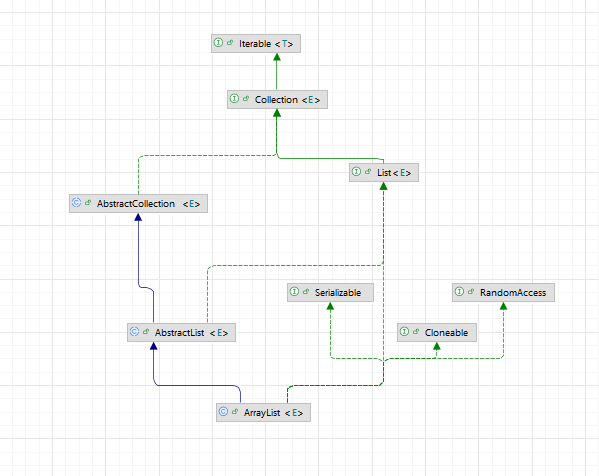Appearance
ArrayList 源码解析
重要概念
ArrayList 是 java 集合框架中比较常用的数据结构,继承自 AbstractList,实现了 List 接口。底层采用数组来实现。ArrayList 实现了java.io.Serializable接口,这意味着ArrayList支持序列化,能通过序列化去传输。
重要特点
- 动态大小:ArrayList 是一个可变大小的数组,它允许存储任何类型的对象,并且可以动态地增加或减少其容量。
- 数组实现:ArrayList基于数组实现,这使得它具有高效的内部数据结构,可以快速随机访问列表中的元素。但是,如果你需要从列表的中间位置插入或删除元素,这可能会涉及到数组元素的移动,所以可能相对较慢。
- 线程不安全:ArrayList 并非线程安全的,如果多个线程同时对 ArrayList 进行读写操作,可能会导致数据不一致。
- 性能:ArrayList的插入和删除操作效率低,因为需要移动数组中的元素。但是,对于随机访问操作,ArrayList的效率较高,因为数组是连续存储的。
类关系
继承了2个抽象类,直接或间接实现了6个接口。
ArrayList继承了抽象类AbstractList,并实现了List、RandomAccess、Cloneable、Serializable等接口。
抽象类AbstractList继承了抽象类AbstractCollection,并实现了List接口;抽象类AbstractCollection实现了Collection接口,Collection接口继承了Iterable接口。
实现RandomAccess接口:表明ArrayList支持快速(通常是常量时间)的随机访问。
实现了Cloneable接口,表明它支持克隆。可以调用clone()进行浅拷贝。
实现了Serializable接口,表明它支持序列化。

java
public class ArrayList<E> extends AbstractList<E>
implements List<E>, RandomAccess, Cloneable, java.io.Serializable
{
}基本结构
ArrayList的底层是一个Object类型的数组elementData,存储元素的顺序的。默认初始容量是10,数组的长度可以动态调整。

重要字段
按惯例,我们先看一下ArrayList的几个重要的字段。
DEFAULTCAPACITY_EMPTY_ELEMENTDATA(默认共享空对象):当创建ArrayList对象未指定大小或指定大小为0时,默认的共享空对象
EMPTY_ELEMENTDATA(共享空对象):当往数组中添加元素时,用来判断数组当前是否是空的
DEFAULT_CAPACITY(默认容量):在往数组中第一次添加元素时,数组容量会从0变成默认容量的大小,也就是10。
elementData(放元素的数组):**重要!!!**这个就是用于存放元素的地方
size(当前元素个数):表示当前存放元素的个数
java
/**
* Default initial capacity.
*/
private static final int DEFAULT_CAPACITY = 10;
/**
* Shared empty array instance used for empty instances.
*/
private static final Object[] EMPTY_ELEMENTDATA = {};
/**
* Shared empty array instance used for default sized empty instances. We
* distinguish this from EMPTY_ELEMENTDATA to know how much to inflate when
* first element is added.
*/
private static final Object[] DEFAULTCAPACITY_EMPTY_ELEMENTDATA = {};
/**
* The array buffer into which the elements of the ArrayList are stored.
* The capacity of the ArrayList is the length of this array buffer. Any
* empty ArrayList with elementData == DEFAULTCAPACITY_EMPTY_ELEMENTDATA
* will be expanded to DEFAULT_CAPACITY when the first element is added.
*/
transient Object[] elementData;ArrayList的构造函数
- 未指定容量大小时: 初始对象未空对象,在添加对象的时候,会先转换为默认的大小10,再添加元素
java
/**
* Constructs an empty list with an initial capacity of ten.
*/
public ArrayList() {
this.elementData = DEFAULTCAPACITY_EMPTY_ELEMENTDATA;
}- 指定初始容量大小时: 立马创建一个指定大小的数组,作为容器
java
/**
* Constructs an empty list with the specified initial capacity.
*
* @param initialCapacity the initial capacity of the list
* @throws IllegalArgumentException if the specified initial capacity
* is negative
*/
public ArrayList(int initialCapacity) {
if (initialCapacity > 0) {
this.elementData = new Object[initialCapacity];
} else if (initialCapacity == 0) {
this.elementData = EMPTY_ELEMENTDATA;
} else {
throw new IllegalArgumentException("Illegal Capacity: "+
initialCapacity);
}
}- 指定存储的元素: 传入集合元素
java
/**
* Constructs a list containing the elements of the specified
* collection, in the order they are returned by the collection's
* iterator.
*
* @param c the collection whose elements are to be placed into this list
* @throws NullPointerException if the specified collection is null
*/
public ArrayList(Collection<? extends E> c) {
elementData = c.toArray();
if ((size = elementData.length) != 0) {
// c.toArray might (incorrectly) not return Object[] (see 6260652)
if (elementData.getClass() != Object[].class)
elementData = Arrays.copyOf(elementData, size, Object[].class);
} else {
// replace with empty array.
this.elementData = EMPTY_ELEMENTDATA;
}
}自动扩容
每当向数组中添加元素时,都要去检查添加后元素的个数是否会超出当前数组的长度,如果超出,数组将会进行扩容,以满足添加数据的需求。数组扩容通过一个公开的方法ensureCapacity(int minCapacity)来实现。在实际添加大量元素前,我也可以使用ensureCapacity来手动增加ArrayList实例的容量,以减少递增式再分配的数量。
数组进行扩容时,会将老数组中的元素重新拷贝一份到新的数组中,每次数组容量的增长大约是其原容量的1.5倍。这种操作的代价是很高的,因此在实际使用时,我们应该尽量避免数组容量的扩张。当我们可预知要保存的元素的多少时,要在构造ArrayList实例时,就指定其容量,以避免数组扩容的发生。或者根据实际需求,通过调用ensureCapacity方法来手动增加ArrayList实例的容量。
java
/**
* Appends the specified element to the end of this list.
*
* @param e element to be appended to this list
* @return <tt>true</tt> (as specified by {@link Collection#add})
*/
public boolean add(E e) {
ensureCapacityInternal(size + 1); // Increments modCount!!
elementData[size++] = e;
return true;
}
private void ensureCapacityInternal(int minCapacity) {
if (elementData == DEFAULTCAPACITY_EMPTY_ELEMENTDATA) {
minCapacity = Math.max(DEFAULT_CAPACITY, minCapacity);
}
ensureExplicitCapacity(minCapacity);
}
private void ensureExplicitCapacity(int minCapacity) {
modCount++;
// overflow-conscious code
if (minCapacity - elementData.length > 0)
grow(minCapacity);
}
/**
* Increases the capacity to ensure that it can hold at least the
* number of elements specified by the minimum capacity argument.
*
* @param minCapacity the desired minimum capacity
*/
private void grow(int minCapacity) {
// overflow-conscious code
int oldCapacity = elementData.length;
int newCapacity = oldCapacity + (oldCapacity >> 1);
if (newCapacity - minCapacity < 0)
newCapacity = minCapacity;
if (newCapacity - MAX_ARRAY_SIZE > 0)
newCapacity = hugeCapacity(minCapacity);
// minCapacity is usually close to size, so this is a win:
elementData = Arrays.copyOf(elementData, newCapacity);
}